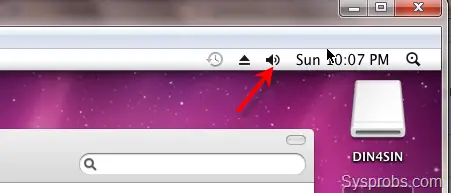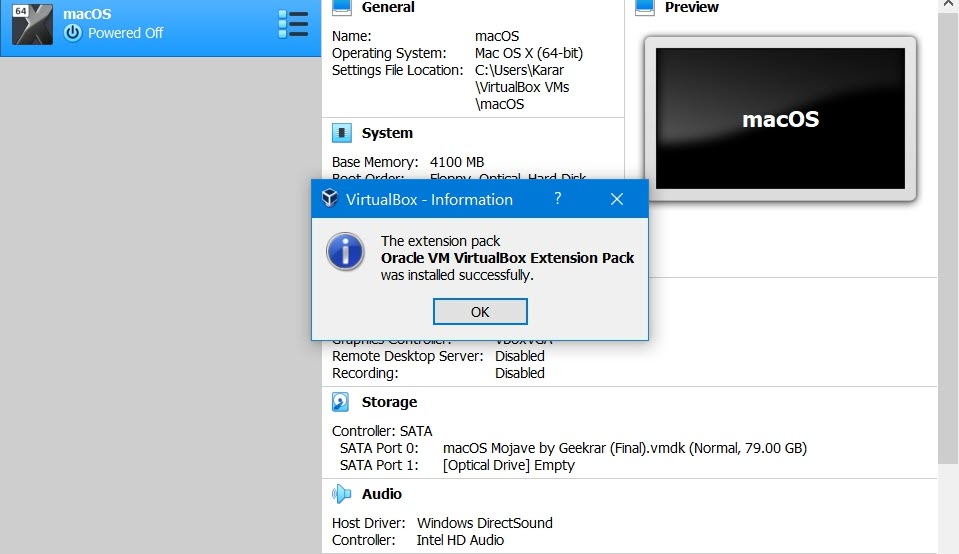VirtualBox is a general-purpose full virtualizer for x86 hardware, targeted at server, desktop and embedded use.For a thorough introduction to virtualization and VirtualBox. Oracle VM VirtualBox is available as Open Source or pre-built Binaries for Windows, Linux, Mac OS X and Solaris. The VirtualBox Extension Pack adds useful new features to this popular virtualisation package. It includes a USB (EHCI) controller, for instance, which should allow. Installing VirtualBox Extension Pack will be started automatically. So, you have to wait for some seconds. Installing Extension Pack Enable USB 3.0 to Fix the problems on macOS. Open the Oracle VM VirtualBox Manager and select the virtual machine for which you would like to.
- Oracle Vm Virtualbox Extension Pack Mac Os X
- Oracle Vm Virtualbox Extension Pack For Mac
- Virtualbox Extension Pack

Oracle VM VirtualBox Base Packages - 6.1.14 Freely available for Windows, Mac OS X, Linux and Solaris x86 platforms under GPLv2: You might want to compare the SHA256 checksum or the MD5 checksum to verify the integrity of downloaded packages. Oracle VM VirtualBox Extension Pack.
User Manual for Release 6.0
E97727-04
Table of Contents

Oracle Vm Virtualbox Extension Pack Mac Os X
- Preface
- 1 First Steps
- 1.1 Why is Virtualization Useful?
- 1.2 Some Terminology
- 1.3 Features Overview
- 1.4 Supported Host Operating Systems
- 1.4.1 Host CPU Requirements
- 1.5 Installing Oracle VM VirtualBox and Extension Packs
- 1.6 Starting Oracle VM VirtualBox
- 1.7 Creating Your First Virtual Machine
- 1.8 Running Your Virtual Machine
- 1.8.1 Starting a New VM for the First Time
- 1.8.2 Capturing and Releasing Keyboard and Mouse
- 1.8.3 Typing Special Characters
- 1.8.4 Changing Removable Media
- 1.8.5 Resizing the Machine's Window
- 1.8.6 Saving the State of the Machine
- 1.9 Using VM Groups
- 1.10 Snapshots
- 1.10.1 Taking, Restoring, and Deleting Snapshots
- 1.10.2 Snapshot Contents
- 1.11 Virtual Machine Configuration
- 1.12 Removing and Moving Virtual Machines
- 1.13 Cloning Virtual Machines
- 1.14 Importing and Exporting Virtual Machines
- 1.14.1 About the OVF Format
- 1.14.2 Importing an Appliance in OVF Format
- 1.14.3 Exporting an Appliance in OVF Format
- 1.14.4 Exporting an Appliance to Oracle Cloud Infrastructure
- 1.14.5 Importing an Instance from Oracle Cloud Infrastructure
- 1.14.6 The Cloud Profile Manager
- 1.15 Global Settings
- 1.16 Alternative Front-Ends
- 1.17 Soft Keyboard
- 1.17.1 Using the Soft Keyboard
- 1.17.2 Creating a Custom Keyboard Layout
- 2 Installation Details
- 2.1 Installing on Windows Hosts
- 2.1.1 Prerequisites
- 2.1.2 Performing the Installation
- 2.1.3 Uninstallation
- 2.1.4 Unattended Installation
- 2.1.5 Public Properties
- 2.2 Installing on Mac OS X Hosts
- 2.2.1 Performing the Installation
- 2.2.2 Uninstallation
- 2.2.3 Unattended Installation
- 2.3 Installing on Linux Hosts
- 2.3.1 Prerequisites
- 2.3.2 The Oracle VM VirtualBox Kernel Modules
- 2.3.3 Performing the Installation
- 2.3.4 The vboxusers Group
- 2.3.5 Starting Oracle VM VirtualBox on Linux
- 2.4 Installing on Oracle Solaris Hosts
- 2.4.1 Performing the Installation
- 2.4.2 The vboxuser Group
- 2.4.3 Starting Oracle VM VirtualBox on Oracle Solaris
- 2.4.4 Uninstallation
- 2.4.5 Unattended Installation
- 2.4.6 Configuring a Zone for Running Oracle VM VirtualBox
- 3 Configuring Virtual Machines
- 3.1 Supported Guest Operating Systems
- 3.1.1 Mac OS X Guests
- 3.1.2 64-bit Guests
- 3.2 Unattended Guest Installation
- 3.2.1 An Example of Unattended Guest Installation
- 3.3 Emulated Hardware
- 3.4 General Settings
- 3.4.1 Basic Tab
- 3.4.2 Advanced Tab
- 3.4.3 Description Tab
- 3.4.4 Disk Encryption Tab
- 3.5 System Settings
- 3.5.1 Motherboard Tab
- 3.5.2 Processor Tab
- 3.5.3 Acceleration Tab
- 3.6 Display Settings
- 3.6.1 Screen Tab
- 3.6.2 Remote Display Tab
- 3.6.3 Recording Tab
- 3.7 Storage Settings
- 3.8 Audio Settings
- 3.9 Network Settings
- 3.10 Serial Ports
- 3.11 USB Support
- 3.11.1 USB Settings
- 3.11.2 Implementation Notes for Windows and Linux Hosts
- 3.12 Shared Folders
- 3.13 User Interface
- 3.14 Alternative Firmware (EFI)
- 3.14.1 Video Modes in EFI
- 3.14.2 Specifying Boot Arguments
- 4 Guest Additions
- 4.1 Introduction to Guest Additions
- 4.2 Installing and Maintaining Guest Additions
- 4.2.1 Guest Additions for Windows
- 4.2.2 Guest Additions for Linux
- 4.2.3 Guest Additions for Oracle Solaris
- 4.2.4 Guest Additions for OS/2
- 4.3 Shared Folders
- 4.3.1 Manual Mounting
- 4.3.2 Automatic Mounting
- 4.4 Drag and Drop
- 4.4.1 Supported Formats
- 4.4.2 Known Limitations
- 4.5 Hardware-Accelerated Graphics
- 4.5.1 Hardware 3D Acceleration (OpenGL and Direct3D 8/9)
- 4.5.2 Hardware 2D Video Acceleration for Windows Guests
- 4.6 Seamless Windows
- 4.7 Guest Properties
- 4.7.1 Using Guest Properties to Wait on VM Events
- 4.8 Guest Control File Manager
- 4.8.1 Using the Guest Control File Manager
- 4.9 Guest Control of Applications
- 4.10 Memory Overcommitment
- 4.10.1 Memory Ballooning
- 4.10.2 Page Fusion
- 5 Virtual Storage
- 5.1 Hard Disk Controllers
- 5.2 Disk Image Files (VDI, VMDK, VHD, HDD)
- 5.3 The Virtual Media Manager
- 5.4 Special Image Write Modes
- 5.5 Differencing Images
- 5.6 Cloning Disk Images
- 5.7 Host Input/Output Caching
- 5.8 Limiting Bandwidth for Disk Images
- 5.9 CD/DVD Support
- 5.10 iSCSI Servers
- 5.11 vboximg-mount: A Utility for FUSE Mounting a Virtual Disk Image
- 5.11.1 Viewing Detailed Information About a Virtual Disk Image
- 5.11.2 Mounting a Virtual Disk Image
- 6 Virtual Networking
- 6.1 Virtual Networking Hardware
- 6.2 Introduction to Networking Modes
- 6.3 Network Address Translation (NAT)
- 6.3.1 Configuring Port Forwarding with NAT
- 6.3.2 PXE Booting with NAT
- 6.3.3 NAT Limitations
- 6.4 Network Address Translation Service
- 6.5 Bridged Networking
- 6.6 Internal Networking
- 6.7 Host-Only Networking
- 6.8 UDP Tunnel Networking
- 6.9 VDE Networking
- 6.10 Limiting Bandwidth for Network Input/Output
- 6.11 Improving Network Performance
- 7 VBoxManage
- 7.1 Introduction
- 7.2 Commands Overview
- 7.3 General Options
- 7.4 VBoxManage list
- 7.5 VBoxManage showvminfo
- 7.6 VBoxManage registervm/unregistervm
- 7.7 VBoxManage createvm
- 7.8 VBoxManage modifyvm
- 7.8.1 General Settings
- 7.8.2 Networking Settings
- 7.8.3 Miscellaneous Settings
- 7.8.4 Recording Settings
- 7.8.5 Remote Machine Settings
- 7.8.6 Teleporting Settings
- 7.8.7 Debugging Settings
- 7.8.8 USB Card Reader Settings
- 7.8.9 Autostarting VMs During Host System Boot
- 7.9 VBoxManage movevm
- 7.10 VBoxManage import
- 7.10.1 Import from OVF
- 7.10.2 Import from Oracle Cloud Infrastructure
- 7.11 VBoxManage export
- 7.11.1 Export to OVF
- 7.11.2 Export to Oracle Cloud Infrastructure
- 7.12 VBoxManage startvm
- 7.13 VBoxManage controlvm
- 7.14 VBoxManage discardstate
- 7.15 VBoxManage adoptstate
- 7.16 VBoxManage closemedium
- 7.17 VBoxManage storageattach
- 7.18 VBoxManage storagectl
- 7.19 VBoxManage bandwidthctl
- 7.20 VBoxManage showmediuminfo
- 7.21 VBoxManage createmedium
- 7.22 VBoxManage modifymedium
- 7.23 VBoxManage clonemedium
- 7.24 VBoxManage mediumproperty
- 7.25 VBoxManage encryptmedium
- 7.26 VBoxManage checkmediumpwd
- 7.27 VBoxManage convertfromraw
- 7.28 VBoxManage getextradata/setextradata
- 7.29 VBoxManage setproperty
- 7.30 VBoxManage usbfilter add/modify/remove
- 7.31 VBoxManage sharedfolder add/remove
- 7.32 VBoxManage guestproperty
- 7.33 VBoxManage guestcontrol
- 7.34 VBoxManage metrics
- 7.35 VBoxManage natnetwork
- 7.36 VBoxManage hostonlyif
- 7.37 VBoxManage usbdevsource
- 7.38 VBoxManage unattended
- 7.38.1 Synopsis
- 7.38.2 Description
- 7.39 VBoxManage snapshot
- 7.39.1 Synopsis
- 7.39.2 Description
- 7.39.3 Examples
- 7.40 VBoxManage clonevm
- 7.40.1 Synopsis
- 7.40.2 Description
- 7.40.3 Command Operand and Options
- 7.40.4 Examples
- 7.40.5 See Also
- 7.41 VBoxManage extpack
- 7.41.1 Synopsis
- 7.41.2 Description
- 7.41.3 Examples
- 7.42 VBoxManage dhcpserver
- 7.42.1 Synopsis
- 7.42.2 Description
- 7.43 VBoxManage debugvm
- 7.43.1 Synopsis
- 7.43.2 Description
- 7.44 VBoxManage cloudprofile
- 7.44.1 Synopsis
- 7.44.2 Description
- 7.45 VBoxManage cloud list
- 7.45.1 Synopsis
- 7.45.2 Description
- 7.46 VBoxManage cloud instance
- 7.46.1 Synopsis
- 7.46.2 Description
- 7.47 VBoxManage cloud image
- 7.47.1 Synopsis
- 7.47.2 Description
- Glossary
Oracle Vm Virtualbox Extension Pack For Mac

Virtualbox Extension Pack
Copyright © 2004, 2020 Oracle and/or its affiliates. All rights reserved. Legal Notices
